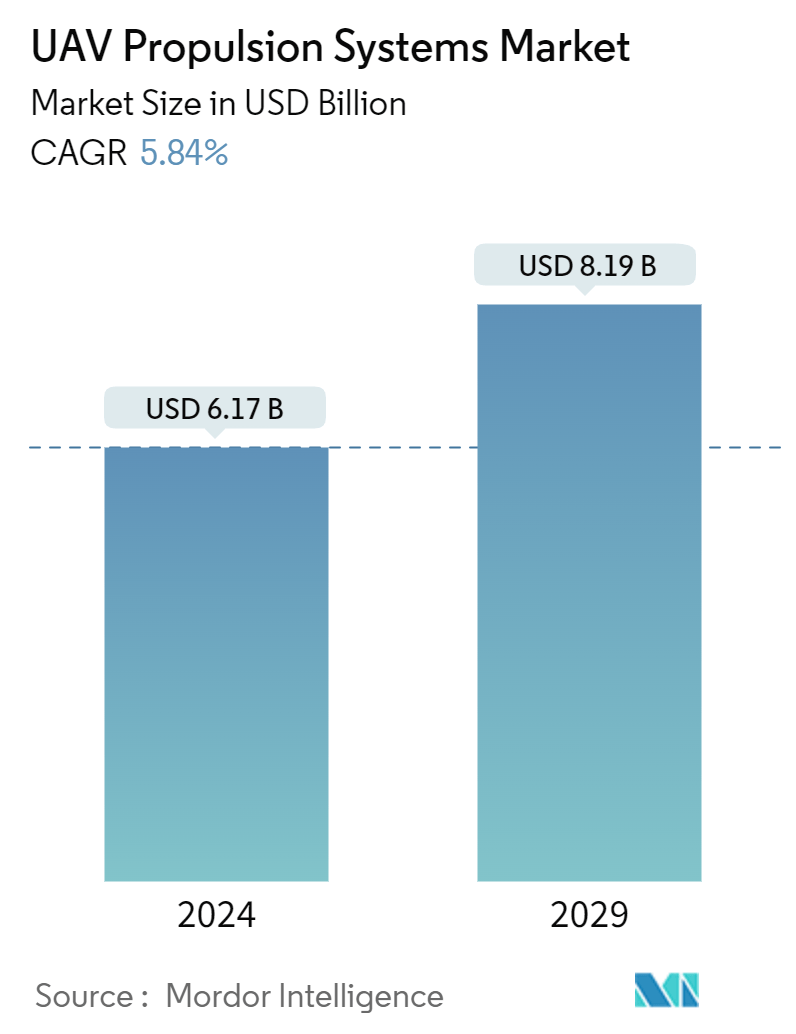
| Study Period | 2019 - 2029 |
| Market Size (2024) | USD 6.17 Billion |
| Market Size (2029) | USD 8.19 Billion |
| CAGR (2024 - 2029) | 5.84 % |
| Fastest Growing Market | Asia Pacific |
| Largest Market | North America |
| Market Concentration | Medium |
Major Players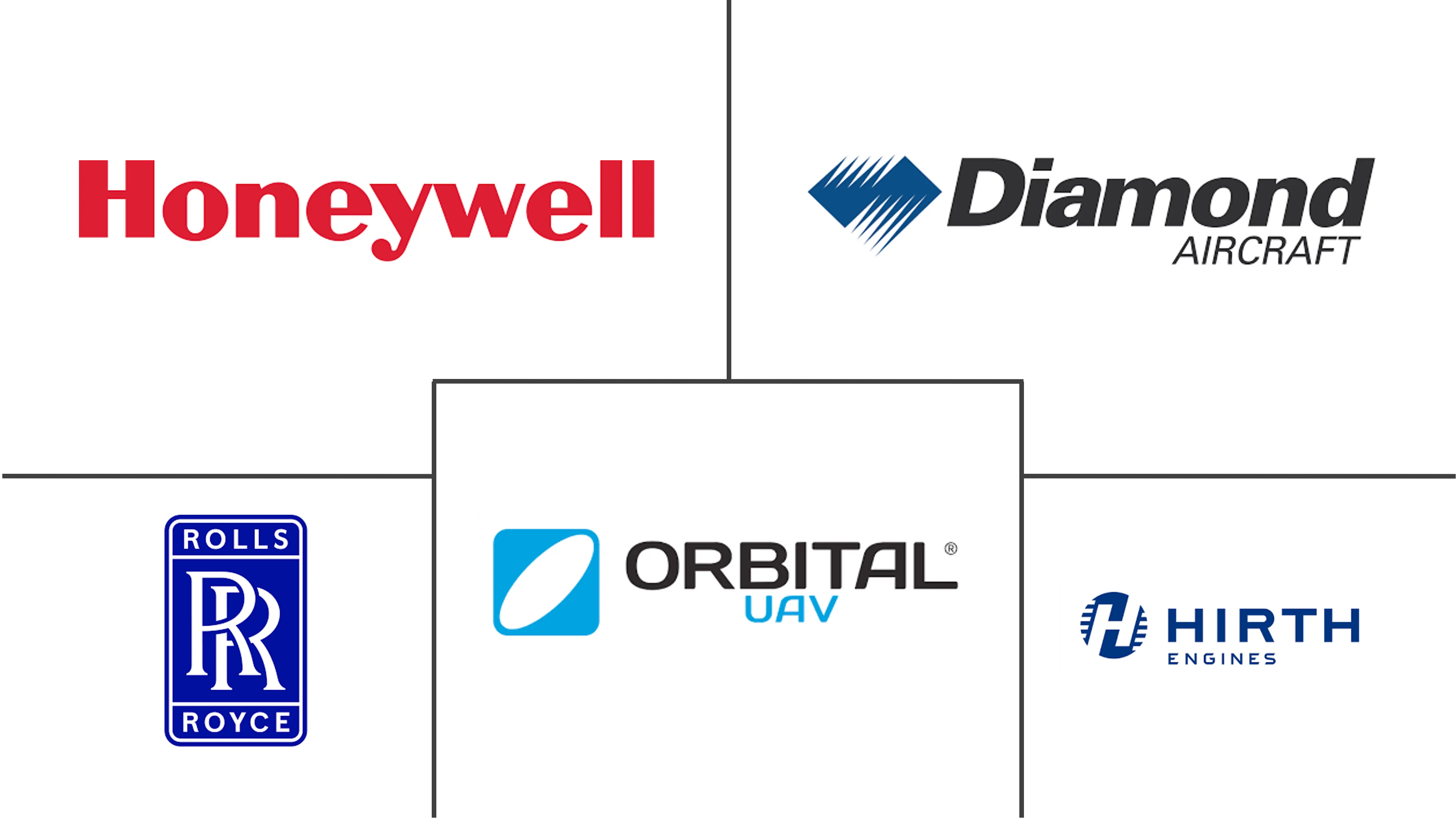
*Disclaimer: Major Players sorted in no particular order |
UAV Propulsion System Market Analysis
The UAV Propulsion Systems Market size is estimated at USD 6.17 billion in 2024, and is expected to reach USD 8.19 billion by 2029, growing at a CAGR of 5.84% during the forecast period (2024-2029).
Over the years, the usage of drones has penetrated several applications in the commercial sector, such as aerial photography, express shipping, and delivery, gathering information or supplying essentials for disaster management, geographical mapping of inaccessible terrain and locations, building safety inspections, precision crop monitoring, unmanned cargo transport, law enforcement and border control surveillance, storm tracking, and forecasting hurricanes and tornadoes. As the customization of commercial UAVs is relatively cheap, it paves the way for new functionalities in a wide array of niche spaces. For instance, sophisticated UAVs are being deployed to fertilize crop fields on an automated basis, monitor traffic incidents, and survey hard-to-reach places.
The inherent benefits of integrating an electric-propulsion system to different UAV platforms are also driving the adoption of electric propulsion technologies much faster than their other counterparts. For instance, an electrical propulsion system provides more flexibility in the installation of machinery as they are compact, and due to the absence of several moving components of the drivetrain, they weigh less and, hence, contribute toward weight savings and endurance enhancement of a particular UAV model. Besides, the emergence of global green emission initiatives has encouraged the adoption of eco-friendly propulsion technologies, such as electric propulsion.
UAVs have evolved into increasingly capable platforms deployed for various applications. The capability to fight effectively in urban areas against widely dispersed forces while minimizing collateral damage and achieving information superiority has enabled UAVs to play a more significant role in critical missions. The endurance of a UAV is influenced by the propulsion technology used and depends on the aerodynamic design and amount of fuel carried. The market players have designed several variants of piston engines and electric motors to fulfill the energy requirements of a large variety of UAVs.
The potential benefits of a propulsion system are measured by their impact on the costs of the whole UAV. Lightweight, more fuel-efficient engines permit the usage of expensive payloads for a given mission without significantly affecting the size and price of the UAV. In recent years, the electric propulsion system has gained more popularity among small or mini-UAVs for its apparent advantages: quiet operation, easy and safe to handle and store, precise power management, and control.
UAV Propulsion System Market Trends
Commercial Segment is Expected to Lead the Market During the Forecast Period
Drone technology is no longer limited to military and homeland uses. UAVs have found a vast number of applications in different commercial industries. There is a rapid rise in the adoption of UAVs for various commercial applications. UAVs are used for close visual inspection of other assets like roof inspection, telco and radio towers inspection, and oil & gas plant inspections. UAVs are utilized for monitoring and management applications such as waste management, road safety, traffic monitoring, highway infrastructure management, natural hazards and disaster relief, and port & waterways.
Commercial UAV manufacturers have long been strategizing to adopt alternative propulsion technologies for UAVs. With several vendors experimenting with such innovative technologies, the dependence of UAVs on fossil fuels has been reduced significantly. Recently, hydrogen fuel cells have emerged as a viable alternative fuel to replace Li-ion batteries in smaller drones, and their efficiency in terms of weight/power ratios is increasing rapidly. They offer compelling value for UAVs due to improved reliability over small internal combustion engines, enhancing safe and low maintenance operation.
UAV systems powered by fuel cells operate longer than their battery counterparts, with the same benefits of low thermal and noise. For instance, in August 2023, the Federal Aviation Administration (FAA) approved the Pelican Spray drone from Pyka for crop protection operations in the US.
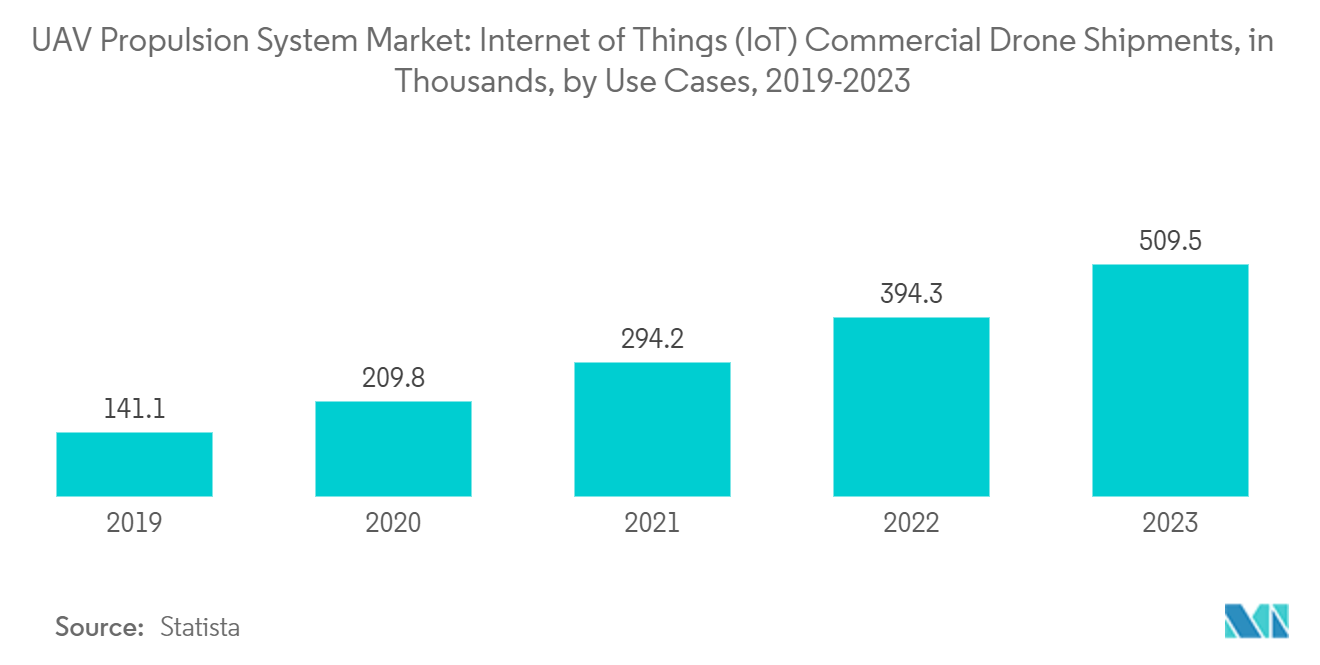
Asia-Pacific is Expected to Generate the Highest Demand During the Forecast Period
The Asia-Pacific region is expected to generate the highest demand for UAV propulsion systems during the forecast period. This increasing demand is mainly due to the increasing orders for different UAV configurations for many military and commercial applications. Investments in drone start-ups are projected to grow in several countries in the region, necessitating the implementation of well-defined regulatory policies. In the Asia-Pacific, several modernization programs are underway to enhance the current capabilities of the commercial and military end-users in the region. For instance, in June 2023, India’s Defense Acquisition Council (DAC) announced the procurement of 31 MQ-98 Predator drones manufactured by General Dynamics Atomics Systems Inc. The procurement cost is USD 3 billion, and acquiring these drones will improve India’s surveillance capabilities beyond its borders.
Additionally, in July 2023, the Indian Armed Forces issued a notice to purchase 97 medium-category and long-endurance 'Made-in-India' drones. Moreover, in October 2022, Garuda Aerospace and Elbit Systems signed an agreement at the Defense Expo for Garuda Aerospace; Elbit Systems signed a deal to provide Skylark 3 UAS drones to commercial and government agencies. Skylark 3 drones implement large-scale surveying and mapping of government village projects. Such developments are envisioned to drive the market's growth prospects in focus during the forecast period.
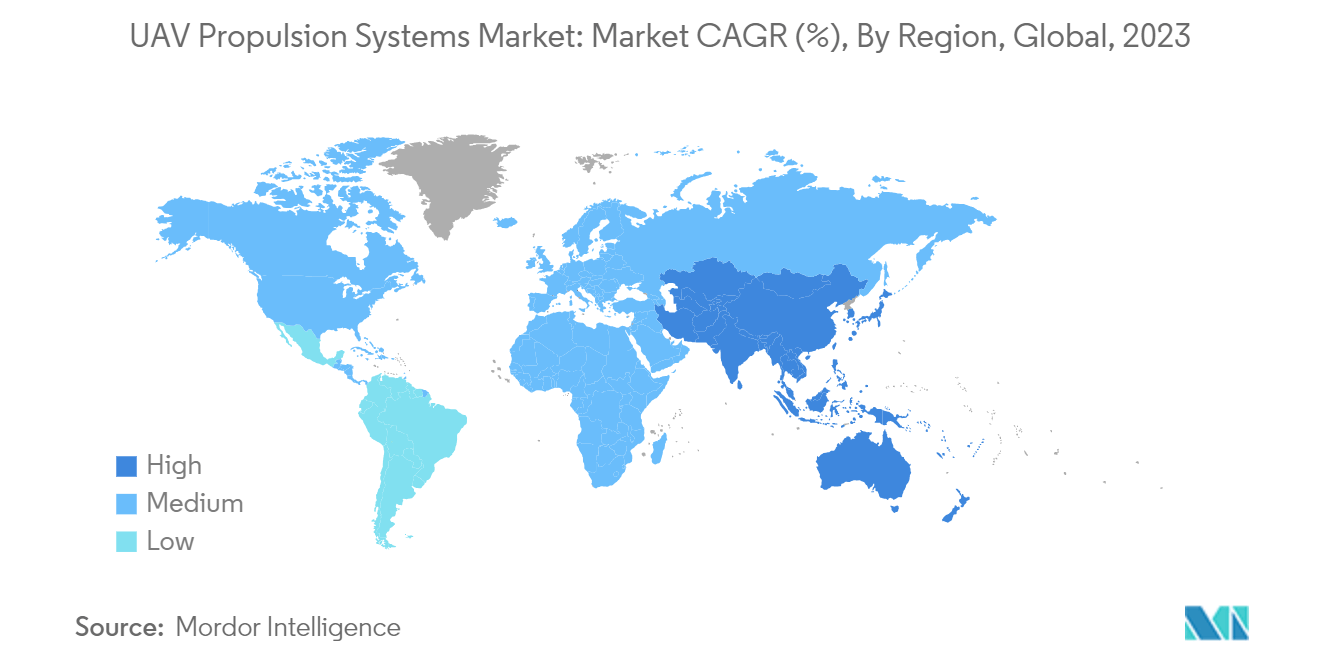
UAV Propulsion System Industry Overview
The UAV propulsion systems market is semi-consolidated. The prominent UAV propulsion systems market players are Orbital Corporation Limited, Diamond Aircraft Industries GmbH, Hirth Engines GmbH, Rolls-Royce plc, and Honeywell International Inc.. These companies are major in designing, manufacturing, and integrating complete propulsion systems for compatible UAV models. The market is highly competitive, and players are releasing products with cross-compatibility. The continuous R&D of prominent market players, such as MMC, to develop advanced UAV propulsion systems and enhance their current capabilities poses a threat to new market entrants.
Additionally, using 3D printing technology in propulsion drives is anticipated to simultaneously generate demand for new system components and designs to cater to the market for sophisticated electric propulsion systems with reduced size and mass without compromising relative performance. For instance, in June 2023, Firestorm Labs partnered with Greenjets to build the first-of-its-kind additively manufactured unmanned aerial Vehicle airframe and engine solution. Similarly, in December 2022, Vertiq won a research grant from the U.S. Air Force to develop its Underactuated Propulsion System for use in UAVs. Vertiq’s Underactuated Propulsion System was to offer UAVs longer flight time and increased maneuverability.
UAV Propulsion System Market Leaders
-
Diamond Aircraft Industries GmbH
-
Hirth Engines GmbH
-
Rolls-Royce plc
-
Honeywell International Inc.
-
Orbital Corporation Limited
- *Disclaimer: Major Players sorted in no particular order
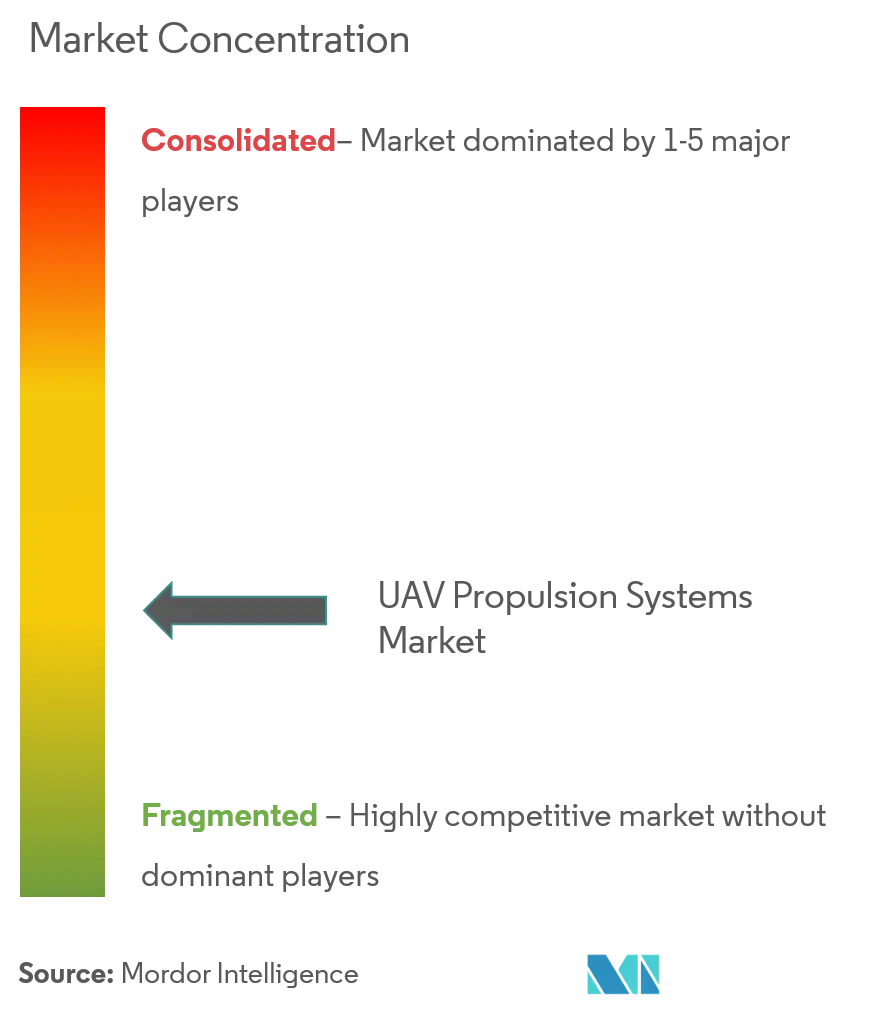
UAV Propulsion System Market News
August 2023: Field Group selected Alva Industries for the ATLUS X60 electric propulsion system to increase the safety and efficiency of infrastructure inspection. The product’s exceptional performance, reliability, and long lifetime made it a good choice. Field Group placed a sizeable initial purchase for installing the systems on the UAV fleet.
December 2022: Orbital Corporation Ltd. and Animal Dynamics signed an agreement to foster collaboration and drive innovation in an advanced propulsion system for Stork-STM UAVs. The collaboration aim was to explore initial concepts for heavy fuel engine systems in Animal Dynamics’s heavy lift uncrewed aircraft systems.
UAV Propulsion System Industry Segmentation
The propulsion system of a UAV produces and supplies the necessary power to ensure continuous flight. While conventional UAV propulsion systems store energy in the form of fuel and utilize an internal combustion (IC) engine to drive the propellers, an electric propulsion system utilizes energy storage devices, such as batteries and fuel cells. In a hybrid configuration, two propulsion technologies are integrated onboard a UAV that works in tandem to eliminate the performance limitations of individual propulsion systems. The market forecast is based on the line-fit installations of propulsion systems integrated onboard the various types of UAVs being delivered across the world.
The UAV propulsion systems market is segmented by type, application, UAV type, and geography. By type, the market is segmented into conventional, hybrid, and full-electric. By application, the market is segmented into civil, commercial, and military. By UAV type, the market is segmented into micro, mini, tactical, MALE, and HALE. The report also covers the market sizes and forecasts for the UAV propulsion systems market in major countries across different regions. For each segment, the market size is provided in terms of value (USD).
| Engine Type | Conventional | |
| Hybrid | ||
| Full-electric | ||
| Application | Civil and Commercial | |
| Military | ||
| UAV Type | Micro UAV | |
| Mini UAV | ||
| Tactical UAV | ||
| MALE UAV | ||
| HALE UAV | ||
| Geography | North America | United States |
| Canada | ||
| Geography | Europe | United Kingdom |
| France | ||
| Germany | ||
| Rest of Europe | ||
| Geography | Asia-Pacific | China |
| India | ||
| Japan | ||
| South Korea | ||
| Rest of Asia-Pacific | ||
| Geography | Latin America | Brazil |
| Mexico | ||
| Rest of Latin America | ||
| Geography | Middle East and Africa | United Arab Emirates |
| Saudi Arabia | ||
| Qatar | ||
| South Africa | ||
| Rest of Middle East and Africa |
UAV Propulsion System Market Research FAQs
How big is the UAV Propulsion Systems Market?
The UAV Propulsion Systems Market size is expected to reach USD 6.17 billion in 2024 and grow at a CAGR of 5.84% to reach USD 8.19 billion by 2029.
What is the current UAV Propulsion Systems Market size?
In 2024, the UAV Propulsion Systems Market size is expected to reach USD 6.17 billion.
Who are the key players in UAV Propulsion Systems Market?
Diamond Aircraft Industries GmbH, Hirth Engines GmbH, Rolls-Royce plc, Honeywell International Inc. and Orbital Corporation Limited are the major companies operating in the UAV Propulsion Systems Market.
Which is the fastest growing region in UAV Propulsion Systems Market?
Asia Pacific is estimated to grow at the highest CAGR over the forecast period (2024-2029).
Which region has the biggest share in UAV Propulsion Systems Market?
In 2024, the North America accounts for the largest market share in UAV Propulsion Systems Market.
What years does this UAV Propulsion Systems Market cover, and what was the market size in 2023?
In 2023, the UAV Propulsion Systems Market size was estimated at USD 5.81 billion. The report covers the UAV Propulsion Systems Market historical market size for years: 2019, 2020, 2021, 2022 and 2023. The report also forecasts the UAV Propulsion Systems Market size for years: 2024, 2025, 2026, 2027, 2028 and 2029.
Our Best Selling Reports
UAV Propulsion Industry Report
Statistics for the 2024 UAV Propulsion market share, size and revenue growth rate, created by Mordor Intelligence™ Industry Reports. UAV Propulsion analysis includes a market forecast outlook 2029 and historical overview. Get a sample of this industry analysis as a free report PDF download.




